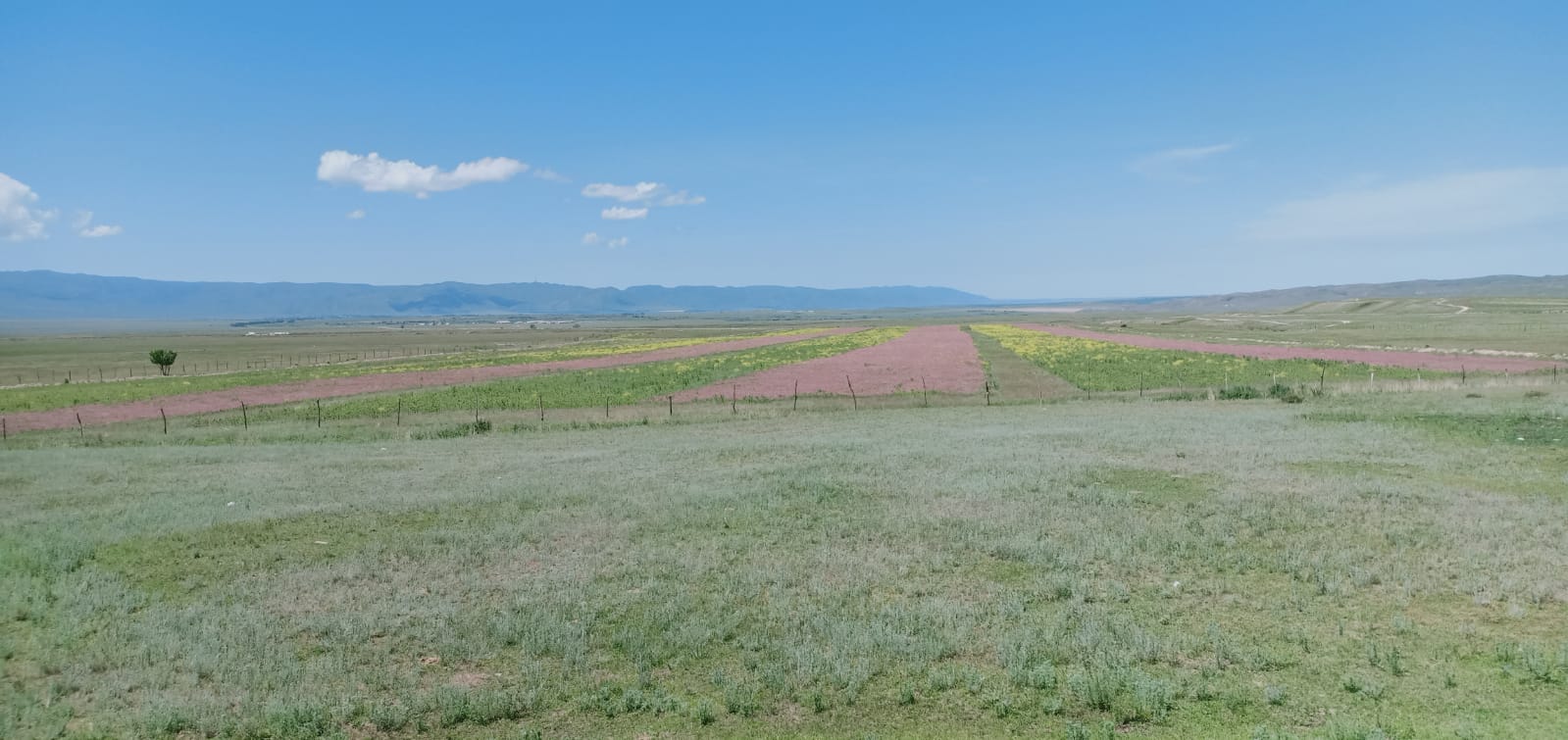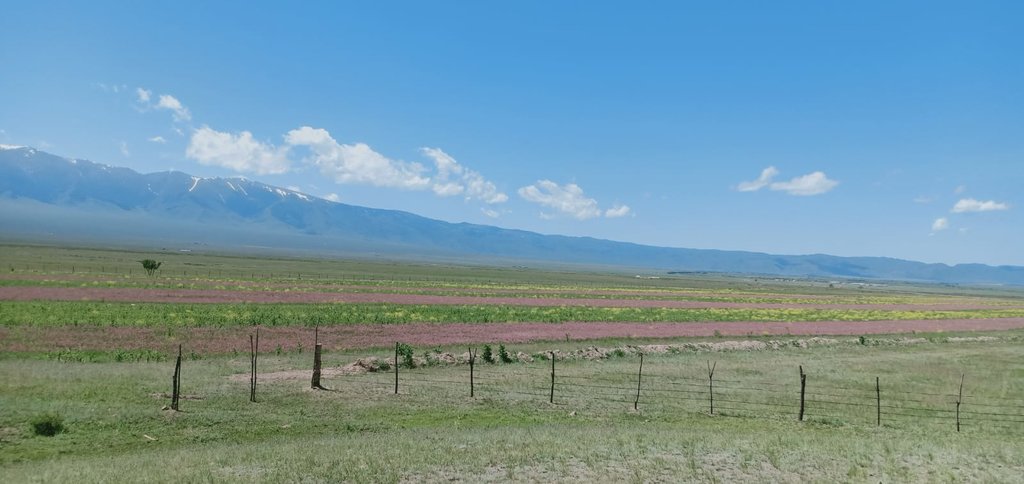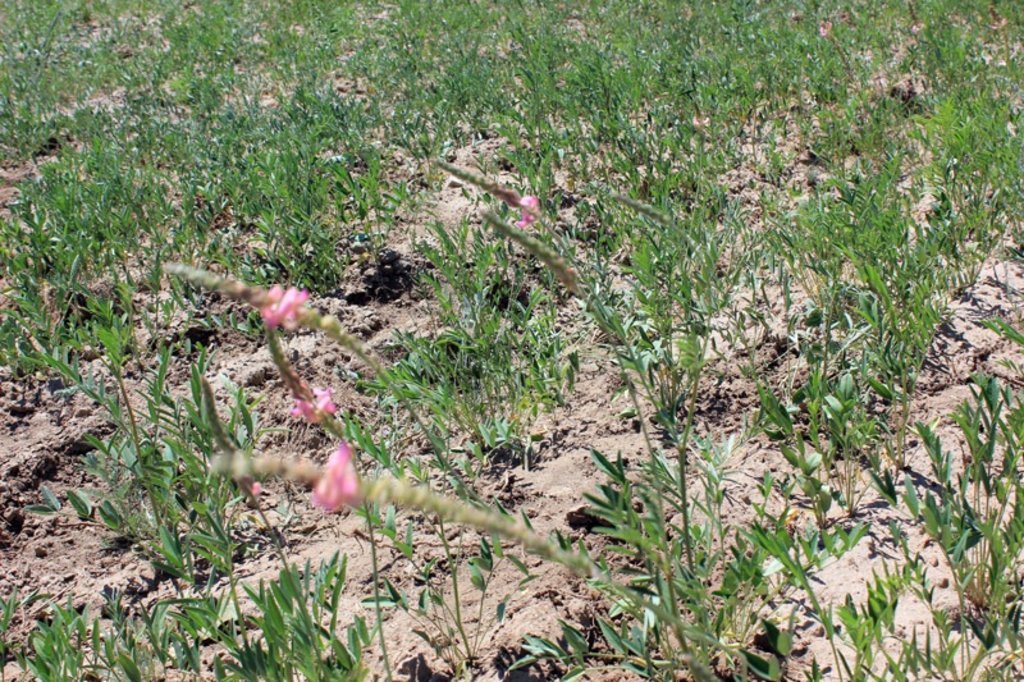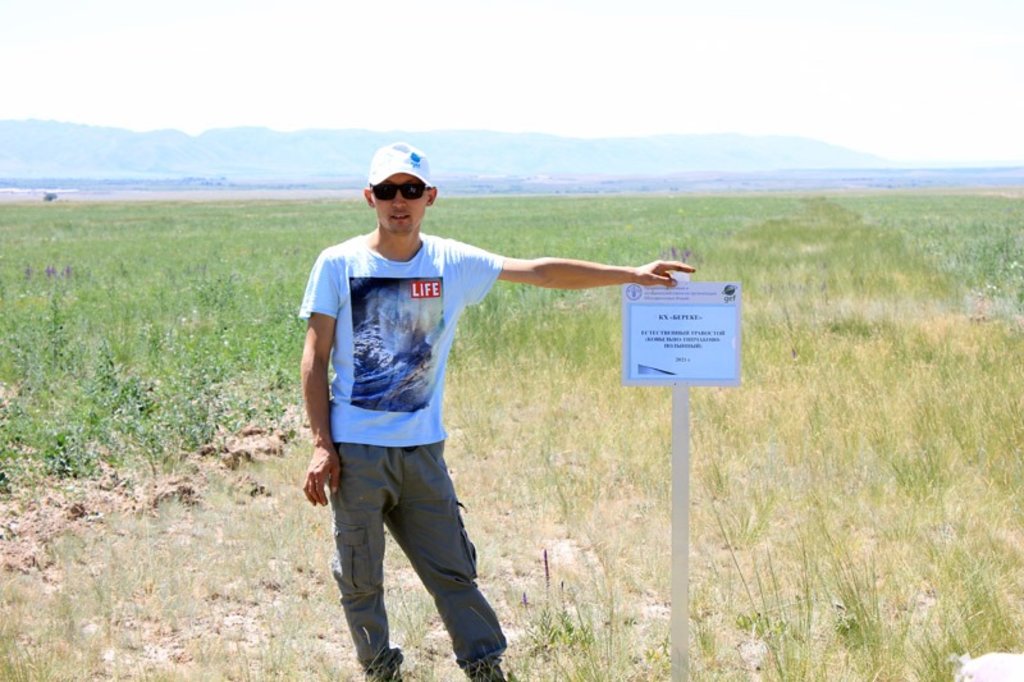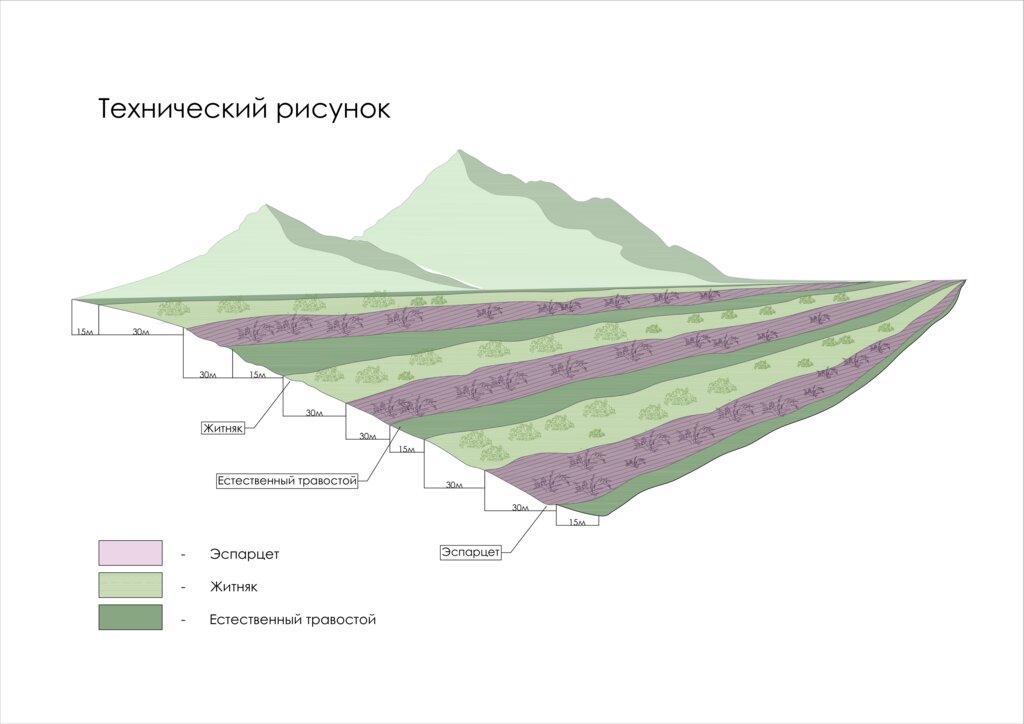Fundamental Improvement of Low-Productivity Pastures through Strip Planting of Perennial Drought-Resistant Grasses in the Foothill Semi-Desert Zone of Southeastern Kazakhstan [Kazakhstan]
- Creation:
- Update:
- Compiler: Kulyash Iskandarova
- Editor: Hayot Ibrakhimov
- Reviewers: Olga Andreeva, Rima Mekdaschi Studer
technologies_6507 - Kazakhstan
- Full summary as PDF
- Full summary as PDF for print
- Full summary in the browser
- Full summary (unformatted)
- Коренное улучшение низкопродуктивных пастбищ путем полосного размещения многолетних засухоустойчивых трав в условиях предгорно-полупустынной зоны юго-востока Казахстана: Dec. 20, 2022 (inactive)
- Fundamental Improvement of Low-Productivity Pastures through Strip Planting of Perennial Drought-Resistant Grasses in the Foothill Semi-Desert Zone of Southeastern Kazakhstan: Aug. 27, 2025 (public)
View sections
Expand all Collapse all1. General information
1.2 Contact details of resource persons and institutions involved in the assessment and documentation of the Technology
land user:
Name of project which facilitated the documentation/ evaluation of the Technology (if relevant)
Integrated natural resources management in drought-prone and salt-affected agricultural production landscapes in Central Asia and Turkey ((CACILM-2))Name of the institution(s) which facilitated the documentation/ evaluation of the Technology (if relevant)
Kazakh Research Institute for Livestock and Fodder Production (Kazakh Research Institute for Livestock and Fodder Production) - Kazakhstan1.3 Conditions regarding the use of data documented through WOCAT
The compiler and key resource person(s) accept the conditions regarding the use of data documented through WOCAT:
Yes
1.4 Declaration on sustainability of the described Technology
Is the Technology described here problematic with regard to land degradation, so that it cannot be declared a sustainable land management technology?
No
Comments:
The technology aims to restore degraded areas through strip sowing of perennial drought-resistant forage grasses
2. Description of the SLM Technology
2.1 Short description of the Technology
Definition of the Technology:
Radical improvement of low-yield pastures by strip placement of perennial drought-resistant grasses in the conditions of the foothill-semi-desert zone of south-eastern Kazakhstan
2.2 Detailed description of the Technology
Description:
Livestock farming is one of the main economic activities in the Kapal rural district of Aksu District, Zhetysu Region, Kazakhstan. The natural pastures are characterized by diverse vegetation, including feather grass (Stipa), fescue (Festuca), izen (Kochia prostrata), teresken (Krascheninnikovia ceratoides), sainfoin (Onobrychis), wormwood (Artemisia), sedge (Carex), brome (Bromus), and bluegrass (Poa). However, the pastures are heavily grazed without adherence to grazing regimes or stocking norms, which leads to their degradation. The low productivity of the rangelands fails to meet the forage needs of the existing livestock population.
To restore degraded natural pastures near the village of Kapal, the FAO/GEF project “Integrated Natural Resources Management in Drought-Prone and Salt-Affected Agricultural Production Landscapes in Central Asia and Turkey” (CACILM-2) introduced a technology aimed at the accelerated improvement of low-productivity pastures through the sowing of perennial legumes (sainfoin) and grasses (crested wheatgrass).
1. Natural and Socio-Economic Conditions
The project site (Farmer Cooperative “Bereke”) is located on a plateau at the foot of the Kapal Range of the Dzungarian Alatau at an elevation of 975 m above sea level, 81 km northeast of Taldykorgan. The average annual precipitation is 300–350 mm. The mean temperature in January is –15 °C and in July +24 °C.
The area lies in a foothill semi-desert arid zone with natural grass–wormwood–forb vegetation and chestnut soils. The site borders mountain slopes with a high content of stones and boulders.
Kapal village is the administrative center of the Kapal rural district of Aksu District, with a population of 3,660 people in 863 households. The main livelihoods are livestock husbandry and crop farming. Land use covers 36,716 ha, including 6,605 ha of cropland, 4,827 ha of pastures, and 2,233 ha of hayfields. Cultivated crops include wheat, barley, and perennial grasses. Livestock numbers include 23,492 sheep, 3,745 goats, 3,300 horses, and 6,561 cattle, of which 2,751 are dairy cows.
2. Key Characteristics and Technical Features of the Technology
This technology is relatively low-cost: sainfoin sowing is required only once every five years, while crested wheatgrass maintains productivity for 20–30 years. Its application increases pasture yields and establishes a sustainable forage base for livestock.
The technology was implemented on 30 ha of land adjacent to Kapal village (Farmer Cooperative “Bereke”). It was introduced within the framework of the “strip-seeding improvement” approach.
3. Objectives and Functions of the Technology
Accelerated improvement of low-productivity pastures through strip sowing of perennial drought-resistant forage crops while maintaining part of the natural vegetation cover.
4. Main Activities and Resources Required
Geobotanical or field survey to assess land suitability (topsoil depth at least 30 cm);
Division of the land into strips: 30 m (perennial crops) alternating with 15 m (natural vegetation);
On strips designated for crops: moldboard plowing (PLN-3.5), disking to 5–10 cm (LDG-5), harrowing (Zig-Zag tooth harrow), and rolling;
Sowing with a grain drill (SZT-3.6), followed by rolling (ZKKSh-6 ring roller). Sowing method: continuous row with 15 cm spacing. Seeding rates: crested wheatgrass 16–18 kg/ha (depth 1.5–2 cm); sainfoin 70–80 kg/ha (depth 4–5 cm).
During the first two years, while plants are establishing, the land is not used for grazing. From the second year, mowing for hay is possible.
If needed, fencing is installed to protect young plants from grazing.
Costs of implementation:
The establishment cost of 1 ha of strip-planted pastures with sainfoin and crested wheatgrass, including soil preparation and seed sowing, is 60,320 KZT (≈ 140.5 USD).
Maintenance costs:
Annually: early spring harrowing to conserve soil moisture (2,970 KZT/ha).
Every 5 years: reseeding sainfoin at a cost of 48,320 KZT/ha (≈ 112.6 USD/ha), covering seed purchase, labor, machinery, fuel, and all necessary agrotechnical measures (plowing, disking, harrowing, rolling, sowing).
5. Advantages and Impacts of the Technology
This technology is recommended for the foothill semi-desert zones of Kazakhstan. Compared to monoculture seeded pastures or degraded natural rangelands, it provides several advantages:
Preserved strips of natural vegetation prevent wind erosion on seeded areas and reduce further degradation;
Strip planting of perennial grasses and natural vegetation provides livestock with more diverse and nutritious forage than monoculture pastures;
Sowing perennial drought-resistant species more than doubles pasture productivity compared to natural pastures;
Crested wheatgrass maintains productivity for 20–30 years with proper management (spring harrowing, rotational grazing), contributing to soil humus and topsoil accumulation;
Sainfoin enriches soil fertility by fixing atmospheric nitrogen, thus improving nitrogen content in the soil;
Both sainfoin and crested wheatgrass are more drought-resistant than most other forage crops.
6. Farmers’ Perceptions of the Technology
Farmers reported the following positive outcomes:
More efficient use of land resources;
Guaranteed forage harvests even in dry years;
Improved forage nutritional quality;
Reduced production costs for livestock products (e.g., beef).
2.3 Photos of the Technology
2.5 Country/ region/ locations where the Technology has been applied and which are covered by this assessment
Country:
Kazakhstan
Region/ State/ Province:
Aksu district, Zhetysu region
Further specification of location:
Kapal village
Specify the spread of the Technology:
- applied at specific points/ concentrated on a small area
Is/are the technology site(s) located in a permanently protected area?
No
Comments:
The technology was applied on a 30-ha site
Map
×2.6 Date of implementation
Indicate year of implementation:
2021
2.7 Introduction of the Technology
Specify how the Technology was introduced:
- through projects/ external interventions
Comments (type of project, etc.):
FAO/GEF project “Integrated Natural Resources Management in Drought-Prone and Salt-Affected Agricultural Landscapes of Central Asia and Turkey” (CACILM-2)
3. Classification of the SLM Technology
3.1 Main purpose(s) of the Technology
- improve production
- reduce, prevent, restore land degradation
- adapt to climate change/ extremes and its impacts
- mitigate climate change and its impacts
- create beneficial economic impact
3.2 Current land use type(s) where the Technology is applied
Land use mixed within the same land unit:
No
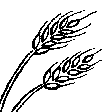
Cropland
- Annual cropping
- Perennial (non-woody) cropping
Perennial (non-woody) cropping - Specify crops:
- fodder crops - legumes, clover
Number of growing seasons per year:
- 1
Is intercropping practiced?
No
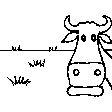
Grazing land
Extensive grazing:
- Semi-nomadic pastoralism
Intensive grazing/ fodder production:
- Improved pastures
Animal type:
- cattle - non-dairy beef
- horses
Is integrated crop-livestock management practiced?
Yes
If yes, specify:
Breeding of beef cattle, production of forage crops, pastures
Products and services:
- meat
Species:
cattle - non-dairy beef
Count:
130
Species:
horses
Count:
60
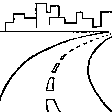
Settlements, infrastructure
- Traffic: roads, railways
Remarks:
Inter-village road
3.3 Has land use changed due to the implementation of the Technology?
Has land use changed due to the implementation of the Technology?
- No (Continue with question 3.4)
Land use mixed within the same land unit:
No
3.4 Water supply
Water supply for the land on which the Technology is applied:
- rainfed
3.5 SLM group to which the Technology belongs
- pastoralism and grazing land management
- integrated crop-livestock management
3.6 SLM measures comprising the Technology
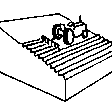
agronomic measures
- A3: Soil surface treatment
A3: Differentiate tillage systems:
A 3.3: Full tillage (< 30% soil cover)

vegetative measures
- V2: Grasses and perennial herbaceous plants
3.7 Main types of land degradation addressed by the Technology
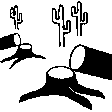
biological degradation
- Bc: reduction of vegetation cover
- Bq: quantity/ biomass decline
3.8 Prevention, reduction, or restoration of land degradation
Specify the goal of the Technology with regard to land degradation:
- reduce land degradation
4. Technical specifications, implementation activities, inputs, and costs
4.1 Technical drawing of the Technology
Technical specifications (related to technical drawing):
The horizontal sowing strips of perennial grasses (sainfoin, wheatgrass) are 30 meters wide and 1111 m long. The horizontal strips of natural grass stand are 15 meters wide and 1111 m long. The slope is less than 1 degree.
Author:
Kanysh Kushenov
Date:
08/12/2022
4.2 General information regarding the calculation of inputs and costs
Specify how costs and inputs were calculated:
- per Technology unit
Specify unit:
ha
other/ national currency (specify):
tenge
If relevant, indicate exchange rate from USD to local currency (e.g. 1 USD = 79.9 Brazilian Real): 1 USD =:
429.3
4.3 Establishment activities
| Activity | Timing (season) | |
|---|---|---|
| 1. | geobotanical survey | April 2021 |
| 2. | dividing a site into strips | April 2021 |
| 3. | plowing | April 2021 |
| 4. | disking | April 2021 |
| 5. | harrowing | April 2021 |
| 6. | pre-sowing rolling | April 2021 |
| 7. | sowing | May 2021 |
| 8. | post-sowing rolling | May 2021 |
4.4 Costs and inputs needed for establishment
| Specify input | Unit | Quantity | Costs per Unit | Total costs per input | % of costs borne by land users | |
|---|---|---|---|---|---|---|
| Labour | moldboard plowing | ha | 1.0 | 1623.0 | 1623.0 | 100.0 |
| Labour | disking | ha | 1.0 | 1039.0 | 1039.0 | 100.0 |
| Labour | harrowing, pre- and post-sowing soil rolling | ha | 3.0 | 974.0 | 2922.0 | 100.0 |
| Labour | sowing | ha | 1.0 | 1074.0 | 1074.0 | 100.0 |
| Equipment | maintenance of equipment | ha | 1.0 | 8028.8 | 8028.8 | 100.0 |
| Equipment | operating costs | ha | 1.0 | 6869.2 | 6869.2 | 100.0 |
| Plant material | wheatgrass | kg | 10.0 | 1200.0 | 12000.0 | |
| Plant material | sainfoin | kg | 35.0 | 600.0 | 21000.0 | |
| Other | payment for diesel fuel (plowing) | ha | 1.0 | 3586.0 | 3586.0 | 100.0 |
| Other | payment for diesel fuel (disking) | ha | 1.0 | 682.0 | 682.0 | 100.0 |
| Other | payment for diesel fuel (harrowing) | ha | 1.0 | 506.0 | 506.0 | 100.0 |
| Other | payment for diesel fuel (pre-sowing rolling) | ha | 1.0 | 242.0 | 242.0 | 100.0 |
| Other | payment for diesel fuel (sowing) | ha | 1.0 | 506.0 | 506.0 | 100.0 |
| Other | payment for diesel fuel (post-sowing rolling) | ha | 1.0 | 242.0 | 242.0 | 100.0 |
| Total costs for establishment of the Technology | 60320.0 | |||||
| Total costs for establishment of the Technology in USD | 140.51 | |||||
If land user bore less than 100% of costs, indicate who covered the remaining costs:
Part of the costs were covered by the FAO/GEF project “Integrated Natural Resources Management in Drought-Prone and Salt-Affected Agricultural Landscapes of Central Asia and Turkey” (CACILM-2)
Comments:
With funding from the FAO/GEF project “Integrated Natural Resources Management in Drought-prone and Salt-affected Agricultural Production Landscapes in Central Asia and Turkey” (CACILM-2), seeds of perennial forage crops (crested wheatgrass and sainfoin) were purchased.
All operating costs related to the use of agricultural machinery (owned by the land user), fuel and lubricants, and labor were covered by the land user.
4.5 Maintenance/ recurrent activities
| Activity | Timing/ frequency | |
|---|---|---|
| 1. | Early spring harrowing to retain soil moisture | annually |
| 2. | Sowing sainfoin | every 5 years |
Comments:
Early spring harrowing is carried out to retain moisture in the soil, evenly distribute plant and root residues, create an optimal soil structure, and aerate the soil.
4.6 Costs and inputs needed for maintenance/ recurrent activities (per year)
| Specify input | Unit | Quantity | Costs per Unit | Total costs per input | % of costs borne by land users | |
|---|---|---|---|---|---|---|
| Labour | implementation of agrotechnical measures | ha | 1.0 | 6658.0 | 6658.0 | 100.0 |
| Equipment | Equipment maintenance costs | ha | 1.0 | 8028.8 | 8028.8 | 100.0 |
| Equipment | Operating costs | ha | 1.0 | 6869.2 | 6869.2 | 100.0 |
| Plant material | Sainfoin seeds | kg | 35.0 | 600.0 | 21000.0 | 100.0 |
| Other | fuel costs (fuel and lubricants) | ha | 1.0 | 5764.0 | 5764.0 | 100.0 |
| Total costs for maintenance of the Technology | 48320.0 | |||||
| Total costs for maintenance of the Technology in USD | 112.56 | |||||
4.7 Most important factors affecting the costs
Describe the most determinate factors affecting the costs:
Purchase of seeds of perennial forage grasses
5. Natural and human environment
5.1 Climate
Annual rainfall
- < 250 mm
- 251-500 mm
- 501-750 mm
- 751-1,000 mm
- 1,001-1,500 mm
- 1,501-2,000 mm
- 2,001-3,000 mm
- 3,001-4,000 mm
- > 4,000 mm
Specify average annual rainfall (if known), in mm:
300.00
Agro-climatic zone
- semi-arid
the climate is sharply continental, the duration of the growing season is about 160 days
5.2 Topography
Slopes on average:
- flat (0-2%)
- gentle (3-5%)
- moderate (6-10%)
- rolling (11-15%)
- hilly (16-30%)
- steep (31-60%)
- very steep (>60%)
Landforms:
- plateau/plains
- ridges
- mountain slopes
- hill slopes
- footslopes
- valley floors
Altitudinal zone:
- 0-100 m a.s.l.
- 101-500 m a.s.l.
- 501-1,000 m a.s.l.
- 1,001-1,500 m a.s.l.
- 1,501-2,000 m a.s.l.
- 2,001-2,500 m a.s.l.
- 2,501-3,000 m a.s.l.
- 3,001-4,000 m a.s.l.
- > 4,000 m a.s.l.
Indicate if the Technology is specifically applied in:
- not relevant
Comments and further specifications on topography:
The site where the technology was applied is located on a plain at the foot of the hills.
5.3 Soils
Soil depth on average:
- very shallow (0-20 cm)
- shallow (21-50 cm)
- moderately deep (51-80 cm)
- deep (81-120 cm)
- very deep (> 120 cm)
Soil texture (topsoil):
- medium (loamy, silty)
Soil texture (> 20 cm below surface):
- medium (loamy, silty)
Topsoil organic matter:
- low (<1%)
If available, attach full soil description or specify the available information, e.g. soil type, soil PH/ acidity, Cation Exchange Capacity, nitrogen, salinity etc.
The soils are alkaline - pH 8.3, non-saline - Es, mS/cm - 0.07, with a low content of organic matter - 2.0%. The nitrogen content is low: ammonium nitrogen - 5.0 mg/kg; nitrate nitrogen - 7.7 mg/kg; mineral nitrogen - 12.7 mg/kg. The phosphorus content is low - 13 mg/kg. The potassium content is high - 607 mg/kg.
5.4 Water availability and quality
Ground water table:
> 50 m
Availability of surface water:
poor/ none
Water quality (untreated):
poor drinking water (treatment required)
Water quality refers to:
ground water
Is water salinity a problem?
No
Is flooding of the area occurring?
No
5.5 Biodiversity
Species diversity:
- medium
Habitat diversity:
- medium
5.6 Characteristics of land users applying the Technology
Sedentary or nomadic:
- Sedentary
- Semi-nomadic
Market orientation of production system:
- mixed (subsistence/ commercial)
Off-farm income:
- 10-50% of all income
Relative level of wealth:
- average
Individuals or groups:
- individual/ household
Level of mechanization:
- mechanized/ motorized
Gender:
- men
Age of land users:
- middle-aged
- elderly
5.7 Average area of land used by land users applying the Technology
- < 0.5 ha
- 0.5-1 ha
- 1-2 ha
- 2-5 ha
- 5-15 ha
- 15-50 ha
- 50-100 ha
- 100-500 ha
- 500-1,000 ha
- 1,000-10,000 ha
- > 10,000 ha
Is this considered small-, medium- or large-scale (referring to local context)?
- medium-scale
5.8 Land ownership, land use rights, and water use rights
Land ownership:
- state
Land use rights:
- leased
Water use rights:
- communal (organized)
Are land use rights based on a traditional legal system?
Yes
Specify:
In accordance with the Land Code of the Republic of Kazakhstan, agricultural lands are leased for a period of 2 to 49 years.
5.9 Access to services and infrastructure
health:
- poor
- moderate
- good
education:
- poor
- moderate
- good
technical assistance:
- poor
- moderate
- good
employment (e.g. off-farm):
- poor
- moderate
- good
markets:
- poor
- moderate
- good
energy:
- poor
- moderate
- good
roads and transport:
- poor
- moderate
- good
drinking water and sanitation:
- poor
- moderate
- good
financial services:
- poor
- moderate
- good
6. Impacts and concluding statements
6.1 On-site impacts the Technology has shown
Socio-economic impacts
Production
crop production
crop quality
fodder production
fodder quality
animal production
risk of production failure
product diversity
land management
Income and costs
expenses on agricultural inputs
farm income
diversity of income sources
workload
Socio-cultural impacts
food security/ self-sufficiency
land use/ water rights
Comments/ specify:
If the land is not used or cultivated, the lease agreement can be terminated and the land returned to the state.
SLM/ land degradation knowledge
Ecological impacts
Soil
soil moisture
soil cover
soil loss
soil crusting/ sealing
soil compaction
soil organic matter/ below ground C
Biodiversity: vegetation, animals
Vegetation cover
biomass/ above ground C
plant diversity
invasive alien species
animal diversity
beneficial species
habitat diversity
Climate and disaster risk reduction
drought impacts
micro-climate
6.2 Off-site impacts the Technology has shown
wind transported sediments
impact of greenhouse gases
6.3 Exposure and sensitivity of the Technology to gradual climate change and climate-related extremes/ disasters (as perceived by land users)
Gradual climate change
Gradual climate change
| Season | increase or decrease | How does the Technology cope with it? | |
|---|---|---|---|
| annual temperature | increase | well | |
| seasonal temperature | summer | increase | well |
| annual rainfall | decrease | well | |
| seasonal rainfall | summer | decrease | well |
Climate-related extremes (disasters)
Climatological disasters
| How does the Technology cope with it? | |
|---|---|
| drought | well |
Other climate-related consequences
Other climate-related consequences
| How does the Technology cope with it? | |
|---|---|
| reduced growing period | well |
6.4 Cost-benefit analysis
How do the benefits compare with the establishment costs (from land users’ perspective)?
Short-term returns:
positive
Long-term returns:
very positive
How do the benefits compare with the maintenance/ recurrent costs (from land users' perspective)?
Short-term returns:
positive
Long-term returns:
very positive
6.5 Adoption of the Technology
- single cases/ experimental
If available, quantify (no. of households and/ or area covered):
1 household, 30 ha
Of all those who have adopted the Technology, how many did so spontaneously, i.e. without receiving any material incentives/ payments?
- 0-10%
6.6 Adaptation
Has the Technology been modified recently to adapt to changing conditions?
No
6.7 Strengths/ advantages/ opportunities of the Technology
| Strengths/ advantages/ opportunities in the land user’s view |
|---|
|
- increased efficiency of land use, increased quantity of products per unit area; - increased nutritional value of feed; - guaranteed yield of forage crops, especially in dry years; - decreased labor costs, decreased costs of production of products - cattle meat. |
| Strengths/ advantages/ opportunities in the compiler’s or other key resource person’s view |
|---|
|
- improved soil structure and water-air regime of soils; - decreased soil degradation; - wheatgrass crops are very profitable economically, since they provide a guaranteed high yield starting from the 4-5th year of crops and up to 30 years; in addition, wheatgrass significantly increases the nutritional value of forage, compared to natural grass; - sainfoin crops - enrich the soil with nitrogen, which affects the yield of forage crops; - sainfoin and wheatgrass are drought-resistant crops, which guarantees a harvest in dry years. |
6.8 Weaknesses/ disadvantages/ risks of the Technology and ways of overcoming them
| Weaknesses/ disadvantages/ risks in the land user’s view | How can they be overcome? |
|---|---|
| Labor and financial costs when launching the technology. The need to have or rent specialized agricultural machinery and tools (grain and grass seeder SZT, ring harrow, etc.). | Cooperation of land users for joint use of agricultural machinery. Organization of machine and tractor stations (MTS) at the level of rural districts and regions. |
| Weaknesses/ disadvantages/ risks in the compiler’s or other key resource person’s view | How can they be overcome? |
|---|---|
| Labor and financial costs for launching the technology and maintaining it (annual harrowing, purchasing seeds and sowing sainfoin every 5 years). |
Cooperation of land users for joint use of agricultural machinery. Allocation of subsidies for the purchase of seeds, or sale of seeds at preferential prices for land users implementing soil-protective technologies that ensure sustainable land use. |
7. References and links
7.1 Methods/ sources of information
- field visits, field surveys
2
- interviews with land users
1
- interviews with SLM specialists/ experts
1
- compilation from reports and other existing documentation
1
When were the data compiled (in the field)?
14/11/2022
7.2 References to available publications
Title, author, year, ISBN:
Recommendation for the radical improvement of degraded pastures using strip placement of perennial forage crops in the conditions of the Almaty region. Meldebekova N.A., Kushenov K.I., Shanbaev K.B., Zhakipova K.B., Oryntay B. 2022
Available from where? Costs?
Almaty: Kazakh Research Institute of Animal Husbandry and Fodder Production
7.3 Links to relevant online information
Title/ description:
Marketing research of agriculture in Kazakhstan Analysis of investment attractiveness of the market
URL:
https://marketingcenter.kz/20/rynok-selskoe-khoziaistvo-kazakhstan.html
Title/ description:
Consolidated analytical report on the state and use of lands of the Republic of Kazakhstan for 2020
URL:
https://www.gov.kz/memleket/entities/land/documents/details/126567?lang=ru
Title/ description:
Consolidated analytical report on the state and use of lands of the Republic of Kazakhstan for 2021
URL:
https://www.gov.kz/memleket/entities/land/documents/details/291911?lang=ru
Links and modules
Expand all Collapse allLinks
No links
Modules
No modules


